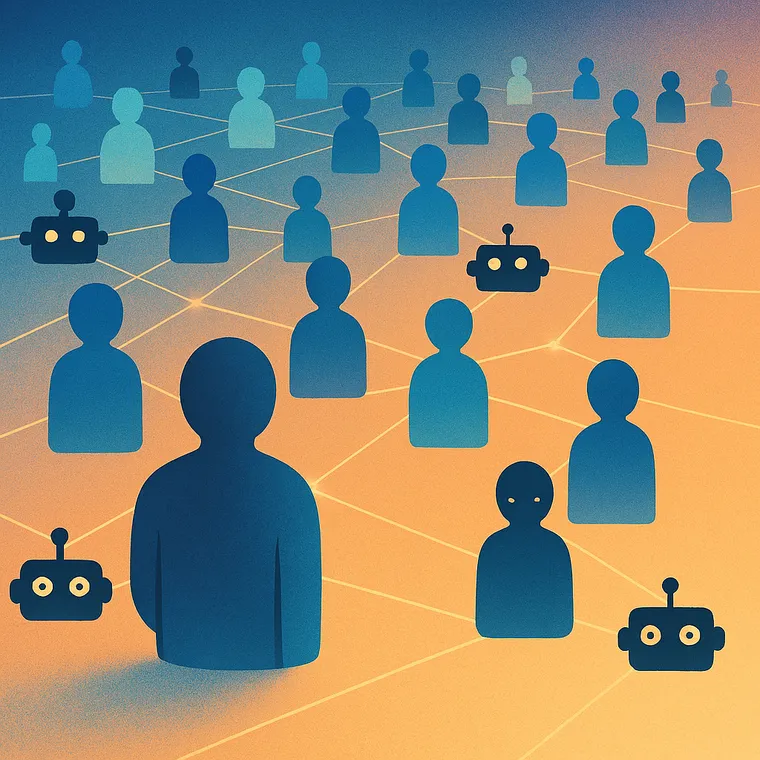Determined to illuminate the pathways of digital evolution, a visionary tech thinker unraveled his perspective during a pivotal speech: “when six billion humans are Googling, who’s searching who? It goes both ways. So we are the Web, that’s what this thing is.” He then added, “So the next 5,000 days, it’s not going to be the Web and only better. — it’s going to be something different. And I think it’s going to be smarter. It’ll have an intelligence in there, that’s not, again, conscious.”
These words were not spoken recently, but in 2007, a bit more than 5,000 days ago, by Kevin Kelly. Today, we are going to talk about the next 5,000 days — we are talking about the potentially conscious web.
The Rise of AI Agents as Nodes on the Web
The web is undergoing a transformative shift. Today, we are witnessing the emergence of AI agents, which are fundamentally altering how we interact with and navigate the digital world. These agents, operating as nodes within the vast network of the internet, are not merely tools but are becoming integral entities — or “users” — of the web, much like humans.
What are Multi-Agent Frameworks?
Multi-agent frameworks allow multiple autonomous entities or “agents” to interact, collaborate, or negotiate with each other to achieve complex goals. These systems are beginning to manifest in various forms, where agents are designed to handle specific tasks or processes in a more dynamic and intelligent manner than traditional single-agent systems.
Multi-Agent frameworks, such as LangGraph, are probably the very beginning of a unique protocol of agentic communication — potentially across the web.
The Beginning of Agentic Communication
The concept of agentic communication represents a significant shift in the web’s architecture. Previously, the web was seen primarily as a repository of information and a medium for human-to-human interaction. Now, with multi-agent frameworks, the web is evolving into a platform where agents communicate, perform tasks, and make decisions independently.
For instance, consider a scenario where ESPN develops an ultimate sports agent, and GitHub nurtures a premier coding agent. These specialized agents could handle specific domain knowledge and tasks, thereby streamlining processes and enhancing productivity. This specialization allows developers to focus more on orchestrating these agents rather than building them from scratch. In order to integrate these agents effectively, it is essential to develop standardized protocols and communication frameworks. This will ensure seamless interoperability between different agents, enabling them to work together harmoniously across various platforms.
The Infrastructure Imperative
As agents become more common on the web, the infrastructure supporting them needs to evolve. The volume of data transferred and processed by these agents will scale massively. Current internet infrastructures may struggle to handle this increased load efficiently. Here, advancements like Starlink could play a crucial role. Starlink’s satellite internet service aims to provide high-speed, low-latency internet globally, which could significantly bolster the backbone needed for these advanced web interactions. This technology is new, but has the potential to scale faster than transatlantic telecommunications cables.
Besides data transfer needs, there will also be a gap in computation power and agent hosting services. Nvidia recently launched NIM, which is designed to provide the computational power necessary for these agents to function efficiently. This will enable more complex and powerful agents to operate seamlessly on the web.
Escalating Security and Privacy Challenges
With agents handling more tasks and accessing vast amounts of data, security and privacy concerns become more pronounced. Developing robust protocols for agentic communication is crucial. These protocols must ensure that agents operate within secure boundaries and that data privacy is maintained, preventing unauthorized access and ensuring that the agents cannot be manipulated by malicious entities.
New cyber attacks can arise. An agent can trick (phishing), but also be tricked (injection). Lately, there were many use cases of agents communicating with companies databases in form of Retrieval Augmented Generation (RAG) pipelines. With agentic RAG pipeline, an agent can generate and execute database queries with an autonomous decision.
Looking Forward: A Call for Responsible Innovation
The integration of multi-agent frameworks into the web is more than just a technological advancement; it’s a redefinition of how the web operates. As these agents become ubiquitous, they will not only change the landscape of internet technology but also challenge our concepts of privacy, security, and data sovereignty. The future of the web looks dynamic and intelligent, driven by agents that operate alongside human users, opening new avenues for innovation and interaction on a global scale.
This transformation, while promising, also calls for a thoughtful approach to infrastructure development, security, and privacy to fully realize the potential of this new web era. As the web continues to weave its intricate tapestry across the fabric of society, understanding its trajectory from the past 5,000 days to the next becomes not just an exercise in technological forecasting but a mandate to secure and shape a future that benefits all.
